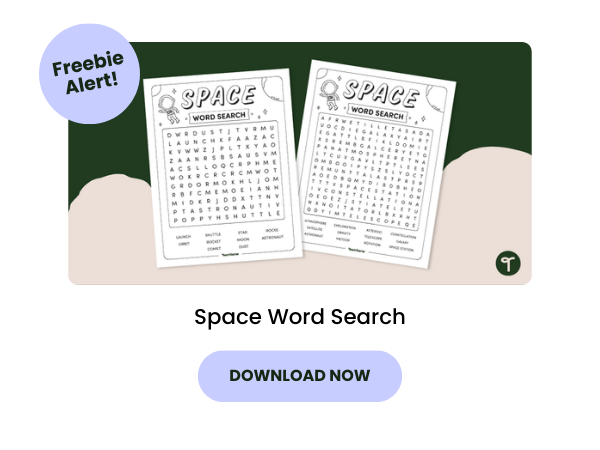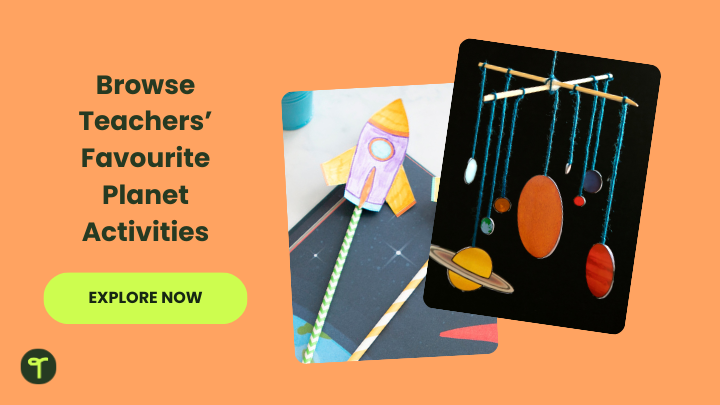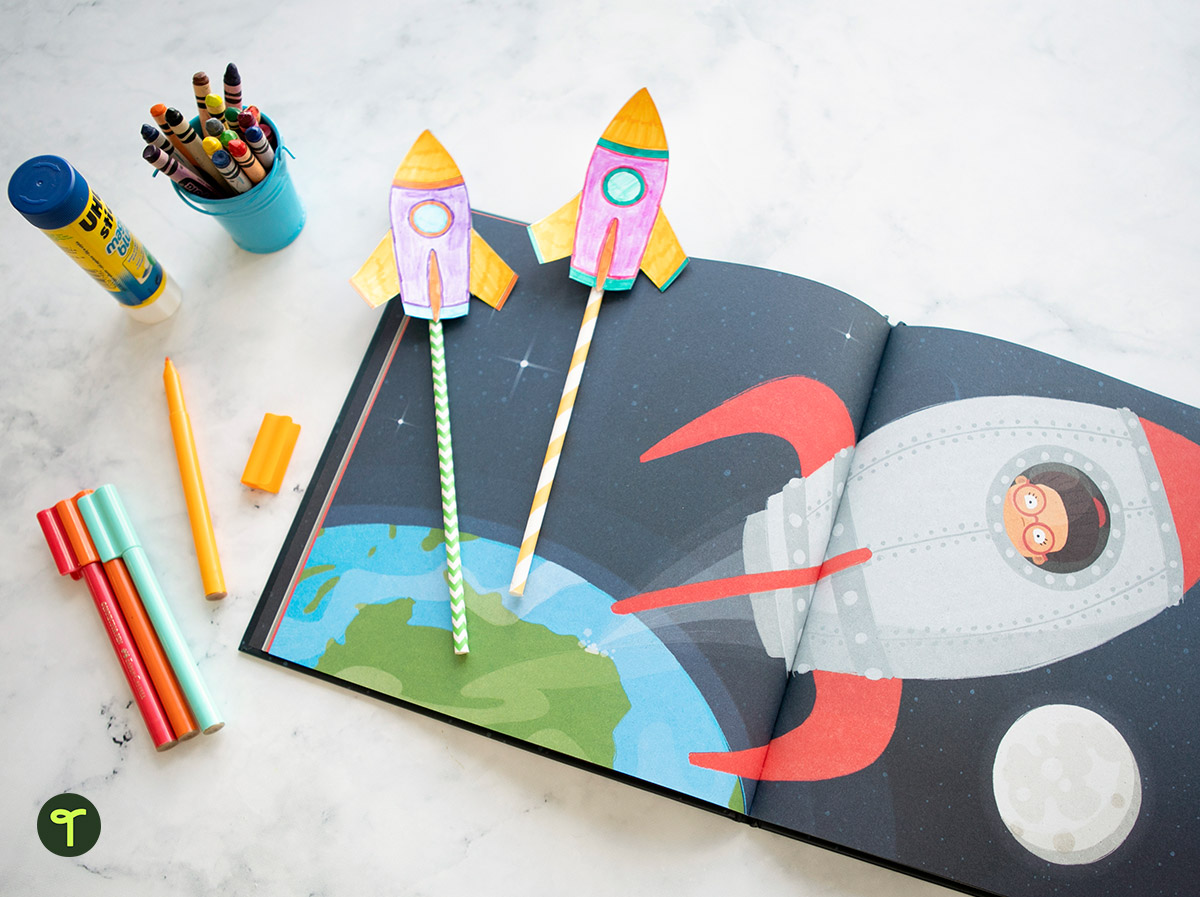World Space Week 2025 is just on the horizon! If you’re looking for engaging and interactive space-themed activities to include in your STEM lessons, then you’ve landed on the right planet!
The Teach Starter teacher squad has searched the galaxy for creative and curriculum-aligned projects, activities, and crafts, plus a few fun facts about iconic Australian astronauts. So, let’s celebrate World Space in the classroom and help our little astronauts reach for the stars!
What Is World Space Week?
Declared by the United Nations (UN), World Space Week marks a global observance dedicated to honouring the advancements in science and technology and acknowledging their role in improving the human condition. This week-long event is perfect for weaving space-related learning into your STEM lesson plans.
When Is World Space Week 2025?
You might think that World Space Week falls on any old week, but it has been celebrated on the exact dates since 1999! World Space Week 2025 will occur from Saturday, 4 October, to Friday, 10 October.

What Is the World Space Week 2025 Theme?
Each year, World Space Week has a different theme to focus on global activities and events. In 2025, the theme is all about ‘Living in Space.’ This theme explores technologies, innovations, and human adaptations necessary for thriving in extraterrestrial environments, from space stations to Mars settlements.
World Space Week Activities to Engage Kids
1. Make Eggnauts
Designed by the European Space Agency, the eggnaut STEM activity can get a bit messy, but it challenges students to think outside the box as they create their own space capsules to keep eggs safe as they blast off — just as a real astronaut would.
Supplies:
- Raw eggs (enough for each student or group of students)
- Straws
- Paper
- Masking tape
- Rubber bands
- Craft sticks
Students use the materials — and any others that you allow (can they choose from others in the classroom?) to build safe spaceships for their eggnauts to make a re-entry from space — aka to be dropped from several metres in the air into a selected space in the classroom.
Want to expand the space activity? You can ratchet up the learning by instructing students to also design landing zones for their eggnauts to enhance safety.
2. Research Famous Space Scientists
A great place to start is by teaching your class about space science and technology pioneers with a research project. Create a list of famous space scientists and astronomers, such as Edwin Hubble and Galileo Galilei, for students to choose one and conduct their research before compiling their findings into a poster presentation to share with the rest of the class.
3. Watch Videos Showing How Astronauts Live in Space
Give your class a glimpse into what life is like for an astronaut in the International Space Station compared to Earth. There are a tonne of videos on YouTube showing how astronauts go about their daily life with little to no gravity, from sleeping to drinking to washing their hair – it’s sure to amaze your students!
Additionally, your class can even track the location of the International Space Station in real-time using NASA’s Spot the Station tool, so you can find out when the Station will be overhead and plan for a class viewing. How cool is that?
4. Make a Time Capsule for Mars
With plans to land the first humans on Mars in 2030, the possibility of future space travel is an exciting concept to weave into your World Space Week activities. So, why not get creative and make a time capsule that might be sent to Mars by future astronauts? Kids can draw on their knowledge of Earth, including its history and cultures, to pop in interesting Earth facts, photos, a small globe and other relevant items in the time capsule.
5. Conduct a Science Experiment Using The Sun’s Heat
What better way to celebrate World Space Week than with a space science experiment? After sharing some fun facts about the sun with your class, challenge them to a hands-on experiment to investigate how the sun generates heat and transfers thermal energy to different objects. Kids can test a variety of different materials, such as grass, mulch, rocks and dirt, to test and measure whether the sun’s heat has reacted.
6. Create a Creature from Another Planet
This exciting extraterrestrial activity requires students to research the fictitious planet of Xubos. The fact sheet provides students with information on the planet and its main habitats.
You may like to use this resource with the Xubosian Creature Report:
- Read the Planet Xubos Fact File
- Select a habitat
- Create a creature that can survive in the selected habitat
- Complete the Xubosian Creature Report
7. Design Unique Spacecrafts
Tap into your students’ entrepreneurial thinking and get them to design their own spacecraft. You can encourage your class to consider what materials their spacecraft would be made, what technology and unique features it might have, and what makes it innovative.
After designing, students can write a short persuasive speech about their decision-making before sharing their design with the rest of the class.
8. Read Books About Space
Reading aloud is always a hit with students, and it can provide an excellent jumping-off point for children’s discussions. Here are a few space-themed books for kids that are perfect for primary students:
- A Hundred Billion-Trillion Stars — An excellent choice for classes interested in STEM and for children with curious minds, this picture book explores numbers! Author Seth Fishman and illustrator Isabel Greenberg bring to light the variation between some of the largest numbers (a hundred billion trillion stars) and smallest numbers (one very unique You) in the universe.
- The Darkest Dark — The debut picture book by astronaut Chris Hadfield, The Darkest Dark tells the story of his childhood decision to become an astronaut after watching the Apollo 11 moon landing.
9. Play a Space-Themed Board Game
Looking for a fun way to practise literacy and numeracy during World Space Week? Create a board game!
Our blank Space Crusade Board Game template can be an engaging activity for any year level. Fill in each empty square with space-related words or facts for students to roll a die and move their way around the game board.
Tip: Laminate your game board and use whiteboard markers to write on each blank square so you can wipe it all off and use the board again!
10. Write a Persuasive Speech for a Space Excursion
Imagine going on a class excursion to space…
Okay, putting aside the logistics of it all, it would be out of this world! Get your class to brush up on their persuasive writing techniques by writing a speech about why the class should embark on an excursion through the galaxy, from first-hand learning opportunities to exciting activities for everyone to do.
Alternatively, students could draw on their creative writing skills to pen a short story about space. Here’s a handful of prompts to help spark an idea or two:
- Lost in Space — Write a story about an astronaut who gets separated from their space crew during a mission and must find their way back to the spaceship.
- Alien Pen Pals — Imagine receiving a letter from a friendly alien who wants to be your pen pal! Encourage kids to write a story about their intergalactic correspondence.
- The Magical Space Suit — Instruct students to write a story about a space suit with magical powers. How does it help the astronaut on their space journey?
- The Galactic Detective — Write a tale about a young detective who solves mysteries on different planets in the solar system, using their knowledge of space science.
11. Get Crafty With a Paper Rocket Activity
Get your little space scientists thinking about motion, force and energy with our Rocket Template craft. This easy paper craft is the perfect activity for downtime or to use as a brain break. Get ready to launch into it!
Materials:
- Rocket template
- Coloured pencils or pens
- Scissors
- Tape
- Thick straws
- Thin straws
- Blu-Tak
Instructions:
- Colour the rocket template and cut it out.
- Cut a piece of thicker straw half the length of the rocket shape.
- Use tape to attach the thicker straw to the back of the rocket, and block the top of the straw with a blob of Blu-Tak.
- Put the thin straw inside the rocket straw.
- Blow into the straw and watch your rocket take off!
- Try variables like different directions, varied speeds, rocket folding, and indoor vs. outdoor use.
12. Take an Excursion to a Planetarium
We know only some towns or cities have a planetarium, but if you have one handy, why not take your class for a day trip? Planetariums and observatories are the perfect place for students to learn about space through immersive experiences and exhibitions and even hear from experts in the field.
Many planetariums, such as The Sir Thomas Brisbane Planetarium, hold shows just for kids so you can book a spot for your class in advance.
13. Build a Solar System Scale Model
This may be an obvious space-related activity, but it’s always fun. Plus, students can brush up on their measurement and geometry skills. Split your class into small groups and assign them a planet to create using different-sized styrofoam balls and paint before assembling the 3D solar system in the classroom. Once finished, the whole class can take a walk through the galaxy and learn more about what makes each planet unique in size, colour and effects on Earth.
Alternatively, each student can make mini versions of the solar system as a diorama before sharing their creation with a fun fact or two about each planet in front of the class.
Australian Astronauts to Share With Your Class
Get your class inspired this World Space Week by sharing interesting facts about some of Australia’s astronauts! Here are a few famous space explorers from right here in Oz!
- Andy Thomas: Andrew ‘Andy’ Thomas is an aerospace engineer and former NASA astronaut who became Australia’s first member of NASA’s elite astronaut corps. He has flown four outer-space missions over 12 years and logged more than 177 days spent in space through his career.
- Paul Scully-Power: Paul Scully-Power is Australia’s first astronaut, having flown aboard the Space Shuttle Challenger in 1984 on NASA mission STS-41-G. He’s also known as the first astronaut to have a beard!
- Meganne Christian: Meganne Christian is a British-Australian-Italian scientist and Exploration Commercialisation Lead at the UK Space Agency. In November 2022, the European Space Agency appointed her a Reserve Astronaut.













how long will this info be available please?
Hi Kylie, We generally keep all of our posts available for good once they have been published. The exception may be if we find an issue with any of the information we have published, however you can rest assured you will be able to access this information for months, and possibly even years to come :) If you have any other questions, please don't hesitate to contact us. Kind regards, Emma